
|   |

|   |
Record breaking dance festival Photos courtesy: Peringottukara Devasthanam June 29, 2024 Peringottukara Devasthanam in Thrissur created a World Record for the Longest Dance Festival. A hitherto little known village in the Thrissur district of Kerala, Peringottukara that lies near the Arabian sea, just 20 kilometres from the main town hosted a marathon season of Indian classical music and dance. The village is dotted with a number of Vishnumaya temples but the one managed by Peringottukara Devasthanam surpasses all others in its beauty and grandeur. The ancient temple has a 400-year-old tradition of worship to the presiding deity Sivanandana, more popularly known as Sree Vishnumaya Swamy who had once taken the form of Lord Mahavishnu when he had wanted to meet his parents, Siva and Parvathi. The Legend The legend has it that once when lord Shiva was wandering in the jungle, he came across a tribal woman, Koolivaka and developed an irresistible fascination for her. She was the devotee of Mother Parvathi. Knowing her plight, Mother Parvathi disguised herself as Koolivaka for union with Shiva and in time gave birth to a child. The child was left with the real Koolivaka. When the child grew up to be a young boy, he came to learn about his real parents. Sivanandana then proceeded to the abode of Siva on a buffalo, blowing his favourite Eezhara. When the dvarapalikas did not allow him to enter the abode of Siva, he assumed the form of Lord Mahavishnu. Thus Sivanandana came to be known as 'Vishnumaya.' About 400 years ago, one Velumuthappan Swami from a Punchanellur family in North Kerala was a devotee of Mother Bhuvaneswari. Once when he had undertaken an intense penance for the protection of his village from certain misery, Maa Bhuvaneswari appeared before him and instructed him to install the idol of Vishnumaya and worship him with deep devotion. Velumuthappan Swami started worshipping Vishnumaya in a shrine built by him at Peringottukara that houses his own samadhi-shrine as well. Today the shrine has become famous as Peringottukara Devasthanam, headed by its fourth generation Devasthanadhipathi Dr. Unni Damodara Swamy. Dakshinamurthy Kala Mandapam Sree Vishnumaya Swamy Temple prides itself on a state-of-the-art indoor stage called Dakshinamurthy Kala Mandapam which was conceived and constructed more than 11 years ago in the living memory of an ardent devotee of Sree Vishnumaya, V. Dakshinamurthy, a famous music composer from the South. The veteran musician was said to frequent the temple and would render devotional hymns in praise of the lord. Moved by his devotion, the management of Devasthanam started an annual Dakshinamurthy Festival of Music and Dance in 2013. Its month-long 11th edition in 2023 was a great success in which artistes from all over India had participated. World's Biggest Dance Festival Encouraged by the enthusiasm of the artistes and the response from the audience, Peringottukara Devasthanam embarked upon a challenging task of running a 100-day-long festival of dance from 9th March to 16th June 2024, in an informal association with Visakhapatnam based Tarakeshwara Foundation. Judged by the Universal Records Forum, Kolkata, as the World's Longest Dance Festival, it had roughly 450 performances by more than 2200 artistes in daily sessions of around three hours each, over 100 days without a day's break in between. The festival was a remarkable journey, showcasing the richness of India's classical and folk dance forms. It covered all the eight major classical dance forms and many regional dances of India that included Koodiyattam, Ottanthullal, and Thiruvathirakali from Kerala, Yakshaganam from Karnataka, Bihu from Assam, Chhau from Jharkhand, West Bengal and Odisha to just name a few. The performances covered a canvas of solos, duets, trios, group recitals and ballets. All performances were streamed live and the acoustic brilliance around the sacred stage that had a large LED wall affording it a dynamic stage backdrop gave the entire setting a state-of-the art studio look and concomitant aura. The curator and P.R.O. of Peringottukara Devasthanam, K.G. Haridas reported having received more than 3500 applications from individual artistes and from the various schools of dance. 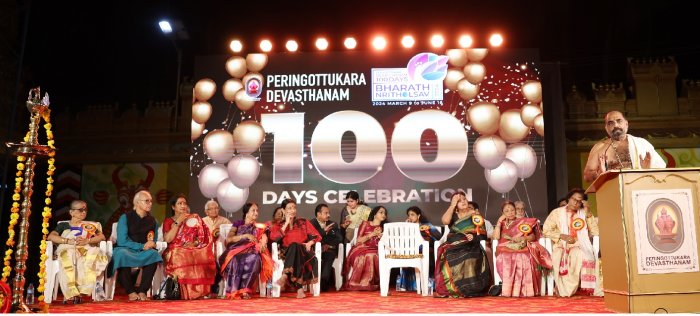 Dr. Unni Damodara Swamy addressing the audience, with dance legends on stage On 16th June, all roads led to Sree Vishnumaya Swamy Temple in Peringottukara. The Temple Devasthanam had planned a grand valedictory function in the evening to celebrate the achievement of the World's Longest Dance Festival post its last session of performances earlier in the morning on that day. A galaxy of dance maestros and gurus descended in the village on invitation from the Devasthanam as special guests. These included Dr. Padma Subrahmanyam, Dr. Mallika Sarabhai, and Chitra Visweswaran (Bharatanatyam); actress and dancer Manju Bhargavi (Kuchipudi); Dr. Methil Devika, Dasyam Gopika Varma and Kala Vijayan (Mohiniattam); Mysore B. Nagaraj (Kathak); Darshana Jhaveri (Manipuri); Gobinda Saikia (Sattriya); Kalamandalam Prabhakaran (Ottanthullal); Venu G. (Koodiyattam); and Prof. Lekha Thankachi (Kerala Natanam). Kathakali guru Kalamandalam Gopi participated through video conferencing. The current Devasthanadhipathi, Dr. Unni Damodara Swamy, presided over the function and received the trophy recognizing the event as the World's Longest Dance Festival from Suneil Joseph, the Chief Editor of the U.R.F., Kolkata. The valedictory function began with the special screening of 'The Crossover,' a short documentary film by Mohiniattam exponent Dr. Methil Devika. This 21-minute film showcases the director-producer's initiative of assimilating Indian Sign Language gestures into the traditional mudras of Mohiniattam dance, primarily to benefit the dance aspirants from the hearing impaired community. Dr. Devika is doing a commendable work in training students from underprivileged section of the society. 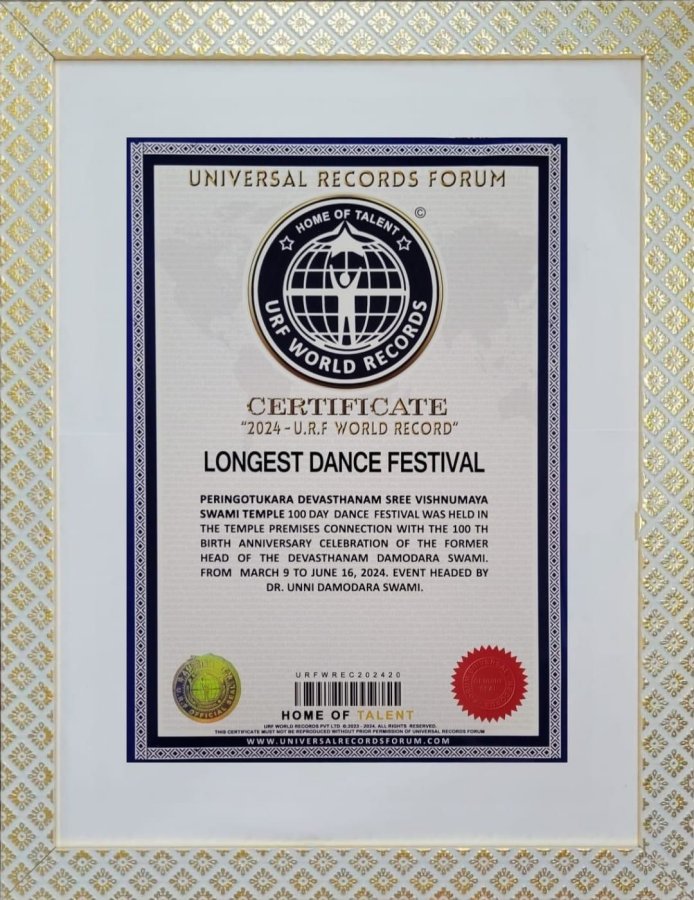 World Record Certificate from Universal Records Forum, Kolkata Dr. Padma Subrahmanyam spoke thereafter and profusely lauded the grand initiative of Peringottukara Devasthanam in creating a world stage for India's classical music and all the classical and folk art forms of the country. A select group of performers received their Certificates of Participation personally on the stage while others would receive them by post. The festival had been inaugurated by Dr. Mallika Sarabhai on the morning of 9th March. Thus started a long journey of 100 days with multiple performances every day between 9am and 1pm. A few glimpses of the performances A dynamic husband and wife duo, Yogesh Kumar and Sneha Narayan from Bangalore gave a thrilling exposition of Bharatanatyam in their duet exposition. A 19-member team from Thillana Arts, Hyderabad, led by Bharatanatyam guru Madhavi Marellapudi, flew all the way to Kochi to perform. It was for the first time in 28 years that the teacher had felt irresistibly inspired to perform along with her disciples which she did and did so admirably well. Feeling blessed, the team flew back to Hyderabad with an impromptu performance at Guruvayur temple on the way. Another large group of 55 members from Hyderabad decided to hire a private bus for their journey to Thrissur for their performance at Sree Vishnumaya Temple. A young girl from Kerala with eighty percent Down Syndrome, Divya Srinivas dazzled on stage with her Bharatanatyam dance on the penultimate day of the festival. She shone brightly on stage with immaculate expressions and downright legitimate exposition of a dance that was akin to that by any accomplished artiste. She is said to be equally adept in Mohiniattam and Kuchipudi. It speaks volume of her parents' unconditional support to and commitment towards her. Her young guru Badusha Master, as he is popularly known as, is solidly behind her. 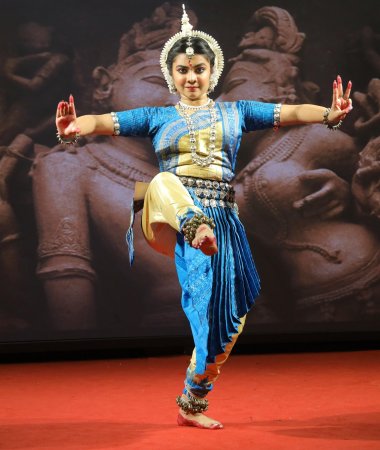 Anusmita Bhattacharjee Odissi dancer Anusmita Bhattacharjee from Kolkata mesmerized the audience with her mystical charm and graceful performance. Bangalore-based Yashomati Mishra, disciple of Guru Ratikant Mohapatra and Sujata Mohapatra, brought her experience and extraordinary talent to the fore on stage. Dr. Neethu Unni's Mohiniattam performance was just like the river Ganges flowing silently and blissfully through the Northern plains before attaining expansion and merging into the sea of infinity! 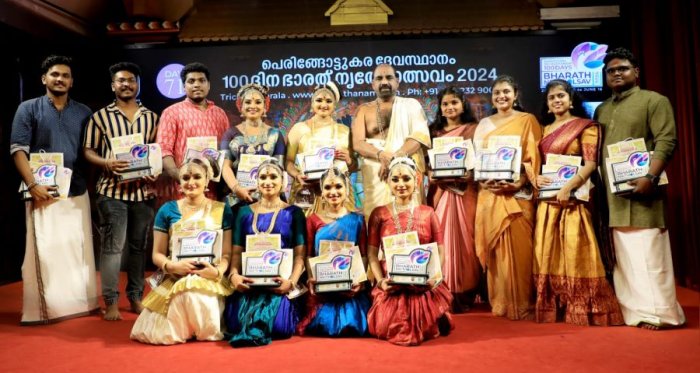 Navadalam dancers Dove-eyed and sharp-featured Veena Prakash - a Thrissur native based in Bangalore - led a group of six dancers and a very talented team of live orchestra under the newly created group Navadalam presented a performance of Bharatanatyam, Kuchipudi and Mohiniattam. Impressed by their performance and exemplary conduct, Peringottukara Devasthanam has offered to host them again whenever they so wish. Scores of Mohiniattam solo, duet and group performances surcharged the sacred venue with the divine effulgence and enchanted the audience. 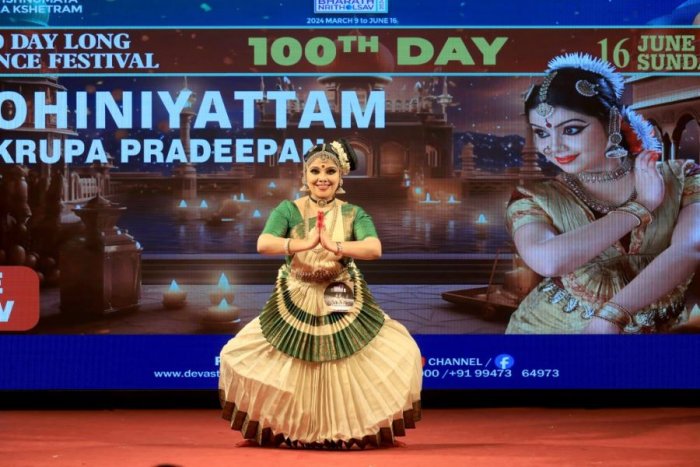 Krupa Pradeepan from Thiruvananthapuram in a Mohiniattam performance Guru Dharmaraj from Kerala, now based in Abu Dhabi, performed Kuchipudi, the major classical dance form of Andhra Pradesh. His whole body appeared to sway with the vibrations of dance even when he was not dancing, so enamoured of the art form he appeared to be! The young siren of Kathak, Yashaswini Shivaraman from Bangalore, and Sushmitha swept everyone in the audience off their feet with their fascinating and dazzling performance of what one would call "Nagaraj Kathak." Their guru Mysore B. Nagaraj has deftly assimilated the compositions of the Vaggeyakaras of the South into the canvas of North Indian Kathak. With their guru seated in the audience, they exhibited mesmerizing swirls and footwork so characteristic of the dance form. When on stage and performing, Yashaswini is just like a poetry in motion. Another pair of disciples of the same guru, Dr. Pooja and Dr. Prarthana also had performed earlier in this festival. They too had given a beautiful and impressive performance. 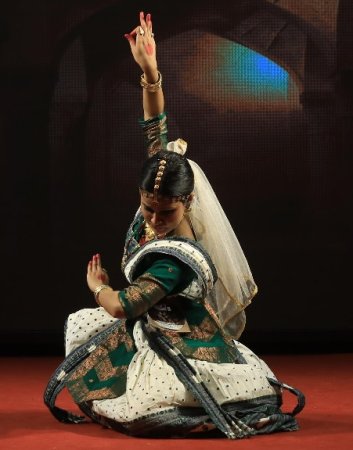 Anannya Mahanta 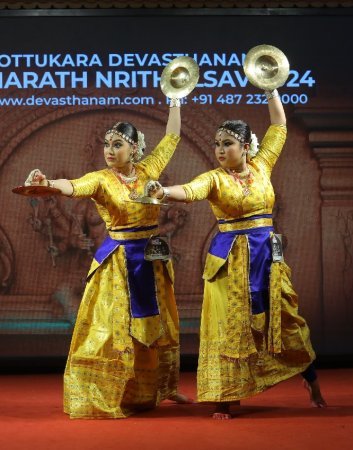 Samragyee Kashyap and Nayanava Sarma Two solos by Anannya Mahanta from Guwahati and by Dr. Dimple Saikia from Majuli in Assam and one duet by Samragyee Kashyap and Nayanava Sarma, also from Guwahati but working in Bangalore, were the three Sattriya dance performances in the festival. Based on the stories and raasleela of child Krishna, this major classical dance from Assam is like a gentle breeze on stage. The artistes from different gurukul traditions called sattras gave commendable performances and delighted the audience to no end. Kerala is best known for India's another major classical dance form, Kathakali. No festival in the State is ever complete without the performance of this dance. Artistes behind Kathakali and their orchestral team members show unparalleled, unwavering dedication and commitment towards this sacred dance. There are many other art forms in Kerala and these include Theyyam, Kolkali, Ottanthullal, Margamkali, Koodiyattam, Chakyar Koothu, Thiriyattam and Thiruvathirakali to name a few of the more popular ones. The practitioners and lovers of Ottanthullal, a dance form said to have been created by an 18th century Malayalam poet, Kalakkaththu Kunchan Nambiar, brought an otherwise relatively little known dance form to the center-stage with their immaculate and sweeping performances. It appeared to score over the more popular Kathakali, stamping its own commanding authority and cementing its beguiling scope for recognition.  Ottanthullal by Kerala Kalalayam Jayasree In one of its performances, young Kerala Kalalayam Jayasree, supported by a veteran vocalist Guru Parameswaran, brought the story of Bhima and Hidimba alive on stage. Performing on an incredibly beautiful live music accompaniment, Jayasree gave a powerful portrayal with remarkable gestures and high-voltage expressions. When she smiled, she smiled as if through the clouds, and when she frowned, she exuded thunderous flares. Everyone in the audience and around in the temple complex remained glued to her performance all through. Guru Parameswaran rendered masterly vocals for support. 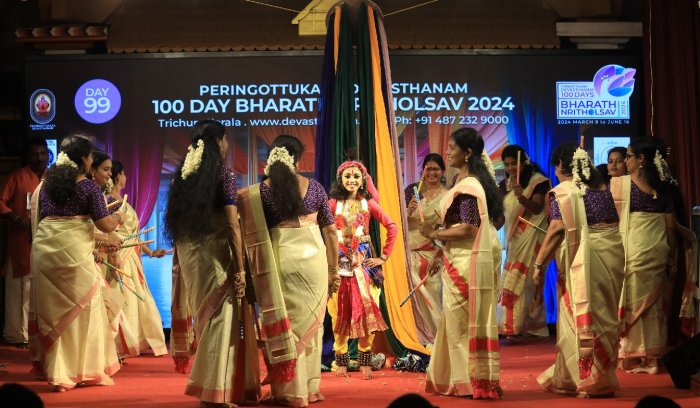 Thiruvathirakali Thiruvathirakali is a dance of loving devotion towards Bhadrakali. Normally it would be a simple and straightforward affair of circumambulatory steps around a lighted deepam on a track full of music. But many Thiruvathirakali performances in this festival were top-notch productions. In one such production, using a fašade of colourful curtains from the ceiling of the stage, a bevy of saree-clad women artistes danced in tandem, singing Krishna bhajans on live music, beseeching Krishna to appear. To everyone's delight, a beautiful boy Krishna with his iconic flute appeared out of the jumble of curtains. Seeing their beloved Krishna, the artistes as simple Vrindavan Gopikas feel overwhelmed and begin dancing in abandon with him. The two young girls who provided live vocal support with the ubiquitous edakka for the company were perfect to the core. 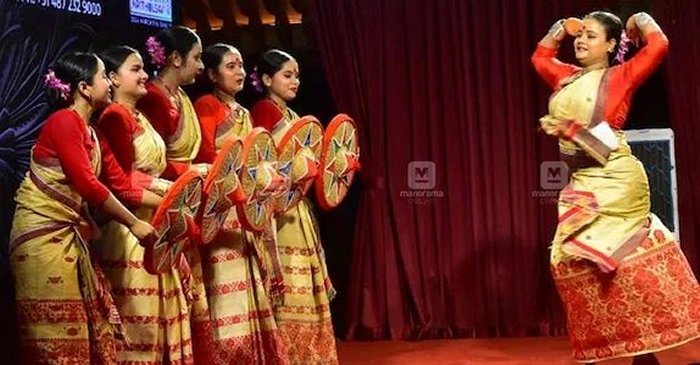 Bihu team led by Guru Mousumi Borah In the lone Bihu dance presentation, a group of young dancers from Guwahati, led by their guru Mousumi Borah, gave a soulful and heart-warming performance. There was a vibrancy and joyfulness, fully reflective of the spirit of dance that celebrates the Assamese New Year. The dance is characterized by brisk steps and rapid hand movements. The traditional costume of dancers is centred around the red colour, signifying joy and vigour. No wonder their performance appeared to raise the spirit of all those in attendance, enlivening the atmosphere all around. When the group got stuck in Thrissur for want of return reservation, the temple authorities came to their rescue and booked return flight tickets for all of them, much to their joy and relief.  Chhau by Anima Das and Sukanya Das Another rare dance form covered in the festival was Chhau with martial art and folk traditions. Named after their place of origin, Chhau dance is found in three styles: the Purulia Chhau of West Bengal, the Seraikella Chhau of Jharkhand and the Mayurbhanj Chhau of Odisha. Chhau dance exponent Madhumita Paul from Purulia has mastered all the three styles. She performed in the festival along with two of her students, Anima Das and Sukanya Das. Madhumita gave a power-packed performance. Her daring acrobatic moves both on and off the stage as the dance form demands, were a visual treat for the audience. The concluding piece was a Mahishasura Mardini act involving all the three members of the team together. Midway through the Festival i.e. on the 50th day, Peringottukara Devasthanam organized a special performance by Navya Nair, Malayalam actress and Bharatanatyam dancer. On this day, the Chief Editor of the U.R.F., Kolkata bestowed on the ongoing event the title of Asia's Longest Dance Festival. The record-breaking dance festival was hosted by Peringottukara Devasthanam in association with Visakhapatnam-based Tarakeshwara Foundation. |